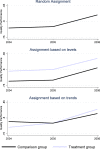Why We Should Not Be Indifferent to Specification Choices for Difference-in-Differences
- PMID: 25495529
- PMCID: PMC4545355
- DOI: 10.1111/1475-6773.12270
Why We Should Not Be Indifferent to Specification Choices for Difference-in-Differences
Abstract
Objective: To evaluate the effects of specification choices on the accuracy of estimates in difference-in-differences (DID) models.
Data sources: Process-of-care quality data from Hospital Compare between 2003 and 2009.
Study design: We performed a Monte Carlo simulation experiment to estimate the effect of an imaginary policy on quality. The experiment was performed for three different scenarios in which the probability of treatment was (1) unrelated to pre-intervention performance; (2) positively correlated with pre-intervention levels of performance; and (3) positively correlated with pre-intervention trends in performance. We estimated alternative DID models that varied with respect to the choice of data intervals, the comparison group, and the method of obtaining inference. We assessed estimator bias as the mean absolute deviation between estimated program effects and their true value. We evaluated the accuracy of inferences through statistical power and rates of false rejection of the null hypothesis.
Principal findings: Performance of alternative specifications varied dramatically when the probability of treatment was correlated with pre-intervention levels or trends. In these cases, propensity score matching resulted in much more accurate point estimates. The use of permutation tests resulted in lower false rejection rates for the highly biased estimators, but the use of clustered standard errors resulted in slightly lower false rejection rates for the matching estimators.
Conclusions: When treatment and comparison groups differed on pre-intervention levels or trends, our results supported specifications for DID models that include matching for more accurate point estimates and models using clustered standard errors or permutation tests for better inference. Based on our findings, we propose a checklist for DID analysis.
Keywords: Hospitals; econometrics; health economics; health policy; quality of care.
© Health Research and Educational Trust.
Figures



Comment in
-
Matching in Difference-in-Differences: between a Rock and a Hard Place.Health Serv Res. 2018 Dec;53(6):4111-4117. doi: 10.1111/1475-6773.13017. Epub 2018 Jul 25. Health Serv Res. 2018. PMID: 30047131 Free PMC article. No abstract available.
Similar articles
-
Now trending: Coping with non-parallel trends in difference-in-differences analysis.Stat Methods Med Res. 2019 Dec;28(12):3697-3711. doi: 10.1177/0962280218814570. Epub 2018 Nov 25. Stat Methods Med Res. 2019. PMID: 30474484
-
Matching and Regression to the Mean in Difference-in-Differences Analysis.Health Serv Res. 2018 Dec;53(6):4138-4156. doi: 10.1111/1475-6773.12993. Epub 2018 Jun 29. Health Serv Res. 2018. PMID: 29957834 Free PMC article.
-
Improving causal inference with a doubly robust estimator that combines propensity score stratification and weighting.J Eval Clin Pract. 2017 Aug;23(4):697-702. doi: 10.1111/jep.12714. Epub 2017 Jan 24. J Eval Clin Pract. 2017. PMID: 28116816
-
Inference With Difference-in-Differences With a Small Number of Groups: A Review, Simulation Study, and Empirical Application Using SHARE Data.Med Care. 2018 Jan;56(1):97-105. doi: 10.1097/MLR.0000000000000830. Med Care. 2018. PMID: 29112050 Review.
-
Comparison of the ability of double-robust estimators to correct bias in propensity score matching analysis. A Monte Carlo simulation study.Pharmacoepidemiol Drug Saf. 2017 Dec;26(12):1513-1519. doi: 10.1002/pds.4325. Epub 2017 Oct 6. Pharmacoepidemiol Drug Saf. 2017. PMID: 28984050
Cited by
-
Association of hospital participation in a quality reporting program with surgical outcomes and expenditures for Medicare beneficiaries.JAMA. 2015 Feb 3;313(5):496-504. doi: 10.1001/jama.2015.25. JAMA. 2015. PMID: 25647205 Free PMC article.
-
Massachusetts Health Reform's Effect on Hospitalizations with Substance Use Disorder-Related Diagnoses.Health Serv Res. 2018 Jun;53(3):1727-1744. doi: 10.1111/1475-6773.12710. Epub 2017 May 19. Health Serv Res. 2018. PMID: 28523674 Free PMC article.
-
Changes in Hospital Inpatient Utilization Following Health Care Reform.Health Serv Res. 2018 Aug;53(4):2446-2469. doi: 10.1111/1475-6773.12734. Epub 2017 Jun 30. Health Serv Res. 2018. PMID: 28664983 Free PMC article.
-
Impact of Molecular Diagnostics for Tuberculosis on Patient-Important Outcomes: A Systematic Review of Study Methodologies.PLoS One. 2016 Mar 8;11(3):e0151073. doi: 10.1371/journal.pone.0151073. eCollection 2016. PLoS One. 2016. PMID: 26954678 Free PMC article.
-
Association between Medicare's Hospital Readmission Reduction Program and readmission rates across hospitals by medicare bed share.BMC Health Serv Res. 2021 Mar 19;21(1):248. doi: 10.1186/s12913-021-06253-2. BMC Health Serv Res. 2021. PMID: 33740969 Free PMC article.
References
-
- Abadie A, Diamond A. Hainmueller J. Synthetic Control Methods for Comparative Case Studies: Estimating the Effect of California’s Tobacco Control Program. Journal of the American Statistical Association. 2010;490(105):493–505.
-
- Ai CR. Norton EC. Interaction Terms in Logit and Probit Models. Economics Letters. 2003;80(1):123–9.
-
- Anger S, Kvasnicka M. Siedler T. One Last Puff? Public Smoking Bans and Smoking Behavior. Journal of Health Economics. 2011;30(3):591–601. - PubMed
-
- Angrist JD. Pischke J-S. Mostly Harmless Econometrics: An Empiricist’s Companion. Princeton, NJ: Princeton University Press; 2008.
-
- Angrist JD. Pischke J-S. The Credibility Revolution in Empirical Economics: How Better Research Design Is Taking the Con out of Econometrics. Journal of Economic Perspectives. 2010;24(2):3–30.
Publication types
MeSH terms
Grants and funding
LinkOut - more resources
Full Text Sources
Other Literature Sources

